Think about the last time you admired someone at work — odds are, they knew their stuff and how to explain it, so it sticks. It might seem like they're born thought leaders, but thought leadership isn't some innate trait. It’s a skill you have to practice.
It’s a skill worth building, too. Why? According to Edelman and LinkedIn’s 2024 Thought Leadership Impact Report, nearly three-quarters of decision-makers (73%) trust thought leadership content more than a company's marketing materials and product sheets.
So, what is thought leadership and how do you become a thought leader? And how do you attract a following that looks to you for insights on the latest trends, challenges, and more? Keep reading to learn what thought leadership is and how to use it.
What Is Thought Leadership, and What Isn’t Thought Leadership?
Let's tackle a big question: what exactly is thought leadership? Turns out it's more than just spouting off facts and figures.
It's leveraging deep knowledge and unique insights in a credible and influential way. But, don’t confuse it for shameless self-promotion. Let's explore what thought leadership is — and, just as importantly, what it isn't.
|
What Thought Leadership Is: |
What Thought Leadership Isn’t: |
|
|
|
|
|
|
|
|
|
|
|
|
|
|
Thought Leadership vs. Traditional Expertise
That begs the question, what sets thought leadership apart from traditional expertise on LinkedIn? It's the approach.
Thought leaders:
-
- Post content that sparks conversation and encourages sharing.
- Engage in discussions and debates on current issues to drive the dialogue forward.
- Offer unique perspectives on solving common problems that show they’re knowledgeable and innovative.
On the flip side, traditional experts tend to:
-
- Focus on their credentials.
- Highlight personal achievements and awards.
- Mainly connect with colleagues and industry peers.
- Share job experiences and responsibilities to show what they've done instead of what they know.
While a traditional expert impresses with their resume, a thought leader connects on a deeper level. Your personal experiences and hard-learned lessons click with people in similar positions because they want to learn from you to save time and effort — and know they’re not alone.
That’s how you build an audience — by providing valuable insights and lessons with authenticity and credibility.
What Are the Benefits of Thought Leadership?
Ideating, writing, and sharing thought leadership is time-consuming if you’re doing it yourself. Time is money, and there has to be a payoff for the effort. So, what is it?
According to Edelman and LinkedIn’s report, nine out of 10 decision-makers and C-suite executives are more likely to engage with a company that consistently produces high-quality thought leadership content than through typical marketing outreach.
It’s not just the C-suite you should care about. According to a 2023 Sprout Social Pulse Survey, nearly half of consumers want to see brands feature more of their employees in their social content. To that end, more engagement means more lead generation, which often means more profit.
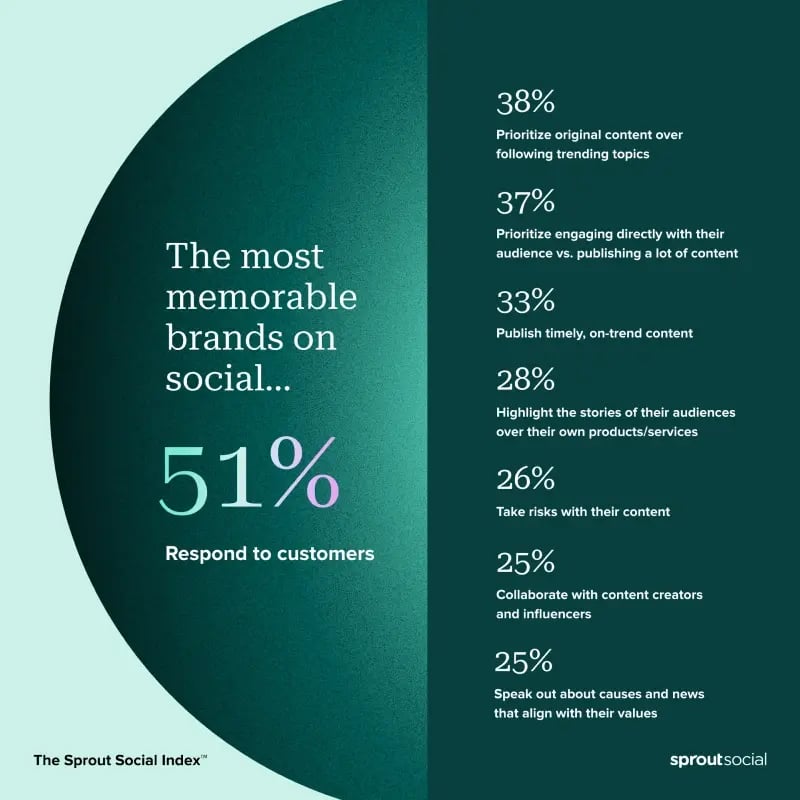 Source: Sprout Social
Source: Sprout Social
You have little to lose and much to gain by posting thought leadership content. So, let’s break down more benefits of thought leadership:
Benefits of Thought Leadership
-
Establish Authority and Credibility
Trust isn't given — you earn it. You create a pattern of trustworthiness when you consistently produce thoughtful, insightful content. Over time, your audience learns who you are, what you stand for, and why you're passionate about your field.
-
Attract Potential Clients and Opportunities
Thought leadership is a magnet for new business. Edelman and LinkedIn’s report also indicates that 52% of decision-makers spend an hour or more each week reading thought leadership content. With a steady stream of top-tier content, your business becomes a must-read in their daily digest.
-
Generate Backlinks, Shares, and Mentions
Quality thought leadership doesn't just attract readers — it attracts attention. So, boost your brand’s visibility and reach by using your content to earn backlinks, shares, and mentions.
-
Build a Strong Brand Presence
Consider your audience the Sherlock Holmes of pattern detection. Consistent, high-quality thought leadership establishes a pattern that boosts brand awareness. It reveals to your audience what your company is and what the people who work there believe.
What Are the Challenges of Thought Leadership?
In any new venture, expect challenges. After all, thought leadership isn't solely publishing one insightful blog post and calling it a day. You’re not finished; publishing thought leadership means playing the long game.
Consistency and content quality are pivotal, but half of thought leadership producers say their biggest obstacle is they’re under-resourced. Who’s going to take on that role? You’re busy. Your team is busy. Do you even have the budget to hire a freelance ghostwriter?
Besides being under-resourced, here are a few more barriers you might face and how to overcome them:
- Balancing Personal and Business Agendas: Be transparent about your affiliations and concentrate on industry challenges. Avoid slipping into over-promotion.
- Ignoring Audience Feedback: Feedback keeps your finger on the pulse of audience sentiment and builds connections and loyalty that are more difficult to break.
- Plagiarizing: Playing fast and loose with content ownership is a big no-no. Always give credit (or, better yet, get permission) when sharing someone else’s content.
- Maintaining Relevance and Authenticity: Share triumphs and trials. Be open to changing your stance when the industry evolves and new info emerges, but always explain why.
Ready for a wake-up call? Edelman and LinkedIn’s report reveals 70% of C-suite executives have questioned their relationship with a supplier based on their thought leadership content. Tread carefully so you don't end up on the wrong end of that statistic.
Who Can Be a Thought Leader?
Anyone with the right mix of skill, critical thinking, and charisma can be a thought leader. At a minimum, good thought leadership comes from original ideas, solid research, and real experience. Googling or watching YouTube videos to find others’ thoughts you can reword and share isn’t good thought leadership.
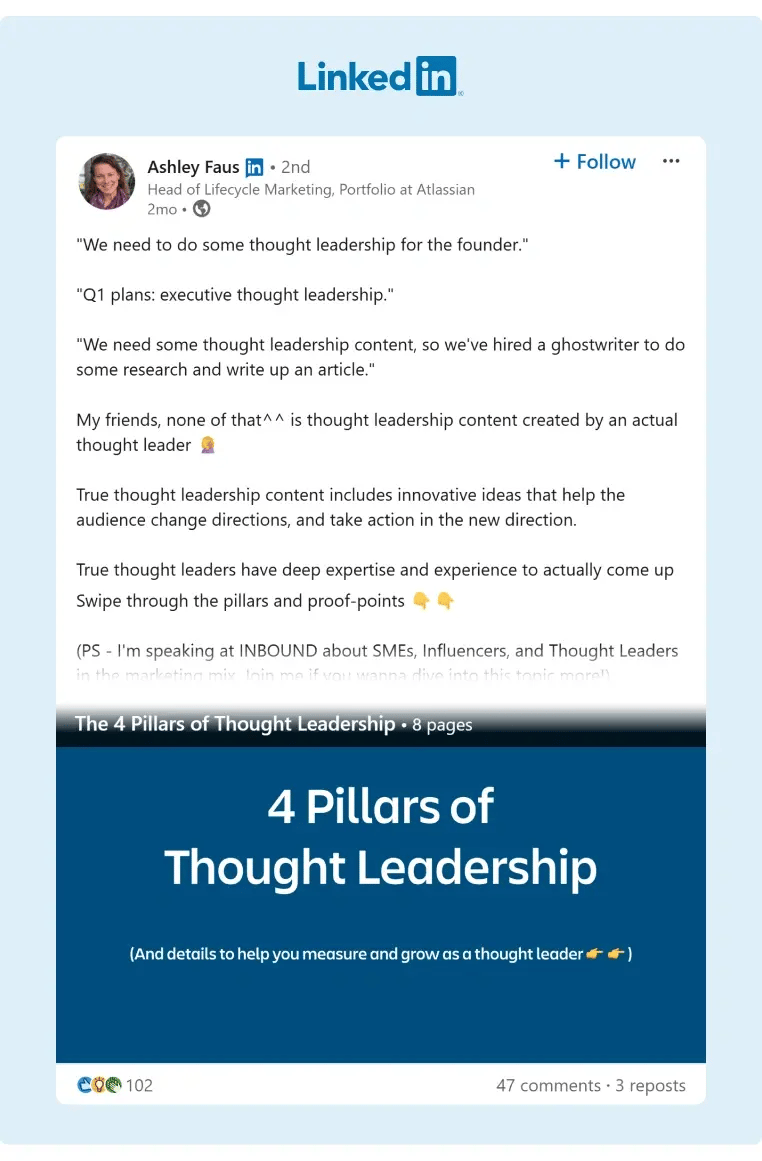
Source: Ashley Faus
Ashley Faus, head of lifecycle marketing at Atlassian, states that you need to find someone with fresh ideas and experience to back them up if you want compelling thought leadership. The ability to share their journey and lessons learned in a relatable way is the cherry on top. That’s how you foster a real connection with your audience.
Identifying Potential Thought Leaders in Your Organization
If, for whatever reason, the thought leader is not you, then who? Potential thought leaders aren't always obvious. To find your employee influencers, here are some traits to look for among your team:
- They’re always coming up with innovative ideas.
- They're passionate about industry trends and challenges.
- They actively participate in industry events or discussions.
- They can write and speak in a clear and captivating manner.
- They are the go-to resource for colleagues on specific topics.
- They can explain complex concepts to their grandmother in a way she understands.
Roles and Responsibilities of Thought Leaders
Is your pick for thought leader up to the task? Are they supposed to do their thought leader duties along with their typical workload? Or, if they move solely into a thought leadership position, how will they maintain a stream of professional experiences to draw from? Being a thought leader comes with a unique set of responsibilities. They might need to:
- Engage with audience and peers across various platforms.
- Represent the company at industry events and conferences.
- Stay informed about industry trends and emerging technologies.
- Measure and report on the impact of thought leadership activities.
- Continuously refine and evolve perspectives based on new information.
- Mentor and develop other potential thought leaders within the organization.
- Regularly produce and share valuable content like articles, videos, podcasts, etc.
- Collaborate with other departments to align thought leadership with business goals.
Remember, thought leadership isn't a title one claims. It's a status earned through consistent effort, valuable insights, and a passion for your field.
How Do You Craft a Thought Leadership Strategy?
You can’t create a robust thought leadership strategy overnight. It's a carefully crafted narrative showcasing your expertise and sharing insights that help your audience navigate their business challenges. It starts by focusing on three attributes:
-
Citing strong research and data.
-
Helping buyers understand their business challenges.
-
Offering concrete guidance.
Nail these three steps, and you're on a steady path toward thought leadership success.
Step 1: Conduct Original Research and Insights
Start with setting aside dedicated time for research and content creation to lay the groundwork for your insights. Deeply rooting your insights in research provides concrete evidence to support your claims.
But, don't stop at research alone. You should share experiences and lessons learned, too. Did you run a successful account-based marketing campaign? Share how it went and the steps you took that made it so successful. Did you make some mistakes along the way? Don't shy away from sharing those, too. It might save someone from making the same ones.
Step 2: Develop a Unique Industry POV
Thought leadership is about sharing your unique perspective. This step is where you'll develop a clear, actionable point of view that makes your social media post stand out and your audience stop scrolling.
Start by creating a content calendar of topics and a posting schedule. Topic ideas pop up organically by keeping up with current industry news and trends. You can also pay attention to conversations in comment sections of your posts and other thought leaders’ posts.
Doing both provides insight into what’s on your audience’s mind. Knowing what your readers are going through lets you empathize with their challenges and find practical solutions.
Next, you want to establish a clear and consistent personal or brand voice. Stick to it across all platforms to give your thought leadership a recognizable identity.
Feel free to get creative with your content structure or format. Take a leaf out of Authority founder Mark P. Jung's book. Like the example below, his creative LinkedIn posts are characterized by:
- Memes, videos, or screenshots.
- Plenty of white space.
- Snappy sentences.
- Emojis.
They’re engaging, easy on the eyes, and guide readers through his content.
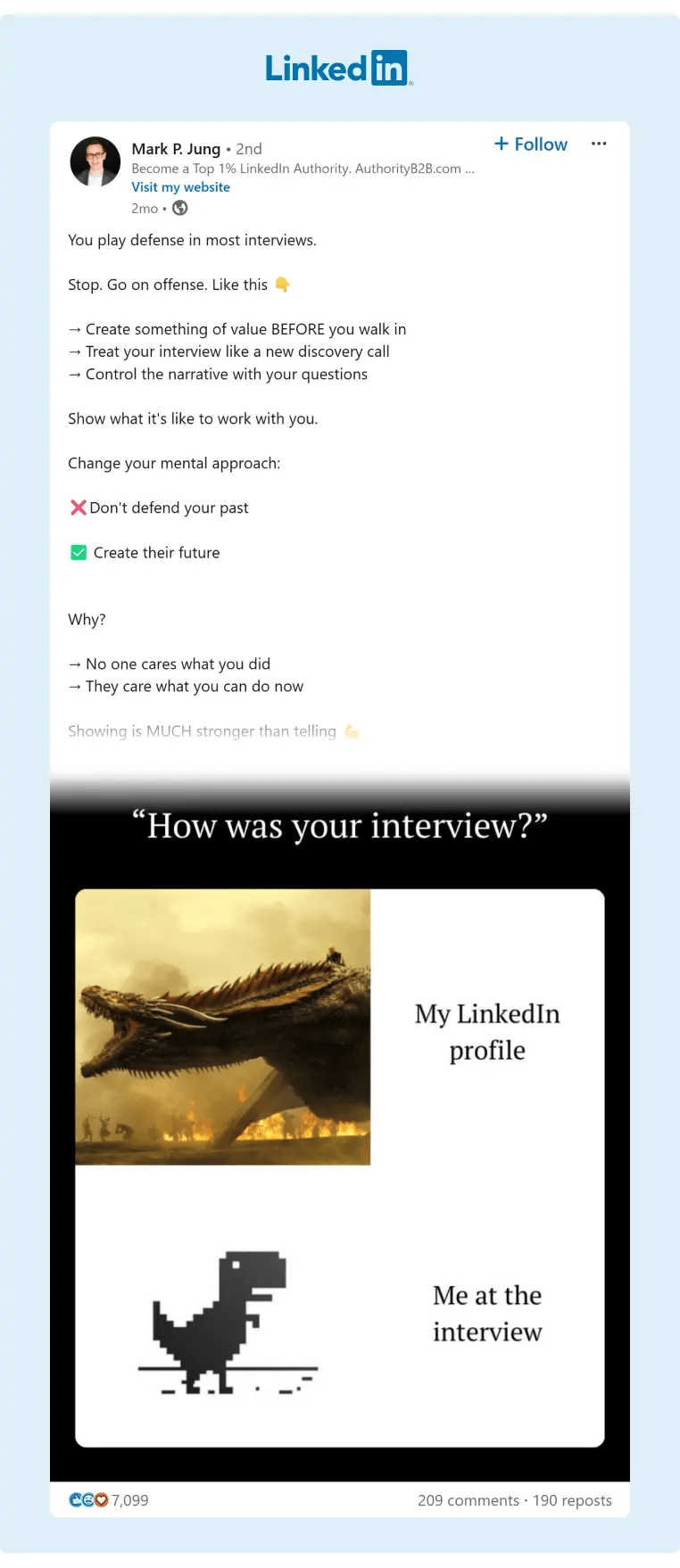
Source: Mark P. Jung
Mark’s approach makes his original take on marketing stand out and makes it more engaging and more comfortable to digest. His followers love it (evident in the 7,110+ reactions). Crafting a distinct industry point of view isn't wheel reinvention — it's serving your insights and experiences with a fresh twist.
Step 3: Distributing and Promoting Your Content
Ready to light the beacon and draw the crowd? Here's how to give your thought leadership reach.
Repurpose Across Different Formats and Platforms
Thought leadership isn’t limited to one platform or format. But, be careful not to overextend yourself here. Trying every platform at once isn’t sustainable. Instead, your content should be where your audience is. So, start with two or three, whether LinkedIn, X (formerly Twitter), industry forums, or your company blog. Share quality posts consistently before adding platforms.
Also, consider repurposing top-performing content into different formats. Transform a popular blog post into a video for YouTube, then slice it into Reels, Shorts, LinkedIn thought leadership posts, and TikToks.
Engage and Collaborate Within Your Network
If you want your thought leadership to gain traction, connect with your network by commenting on and sharing others' posts. While you’re at it, respond to comments on your posts to boost visibility and foster relationships.
Once in the groove, collaborate with other thought leaders and influencers for cross-promotion. When you speak at conferences or webinars, reference your content.
Finally, encourage other employees to share your content through their channels. GaggleAMP’s employee advocacy tools simplify this so that even the busiest (or least tech-savvy) employees can post in a snap.
Measure and Refine Your Strategy
Want to check your progress? To see if all the effort is paying off, measure your impact using LinkedIn's analytics tools. Here are some metrics you can track:
- Likes.
- Shares.
- Post views.
- Comments.
- Profile views.
- Follower growth.
Then, look for patterns in your high-performing content. Which topics get more engagement? When's the best time to post? And what types of content (text, images, videos) perform well? Once you know, use those answers for the next step.
Adjust Strategy Based on Audience Reception and Engagement
What will you do with all of that data? The same thing you do when making business decisions: adjust strategy based on these insights.
That means you post more of what works, cut what doesn't, and schedule your posting times based on your audience's activity. The key is constantly refining your content strategy based on what resonates with your audience.
Effective distribution and promotion make the difference between your content being a hit or a miss. So, get your content out there, engage with your network, and don't forget to measure, refine, and adjust.
What Are Some Examples of Successful Thought Leadership?
Each of these examples showcases a unique approach to thought leadership. The first case study is building a personal brand. The second is balancing personal and business branding. And the third uses expertise across multiple companies. Let's uncover their strategies.
Case Study 1: Emma Stratton Turns B2B Messaging on Its Head
Emma Stratton, founder of Punchy, is a beloved force in the B2B marketing world. With a knack for simplifying complex jargon, she helps tech companies craft accessible, relatable messaging.
She uses the same strategies she teaches in her LinkedIn thought leadership posts, often telling stories that stick, like this one:
Source: Emma Stratton
She's a consultant and an author, too (which only adds to the thought leader status). Emma and her many connections are plugging her recently published marketing book, "Make It Punchy." This post gives a behind-the-scenes look at what it feels like to finally hold your hard work in your hands.

Source: Emma Stratton
Takeaway: Emma's journey underscores the power of compelling storytelling. Also, she shows how you can package your industry expertise into digestible, shareable formats like books. Pair this with an active social presence, and you've got a recipe for boosting engagement, enhancing credibility, and strengthening your brand.
Case Study 2: Dave Gerhardt Nails Dual-Branding
Dave Gerhardt is a B2B marketer known for his brand-building prowess at companies Drift and Privy. Now, Gerhardt is building Exit Five, a thriving community for B2B marketers. His path involves balancing his personal brand and business brand to build awareness for the Exit Five community. To do this, he and his employees share thought leadership on his, Exit Five’s, and employees’ LinkedIn pages.
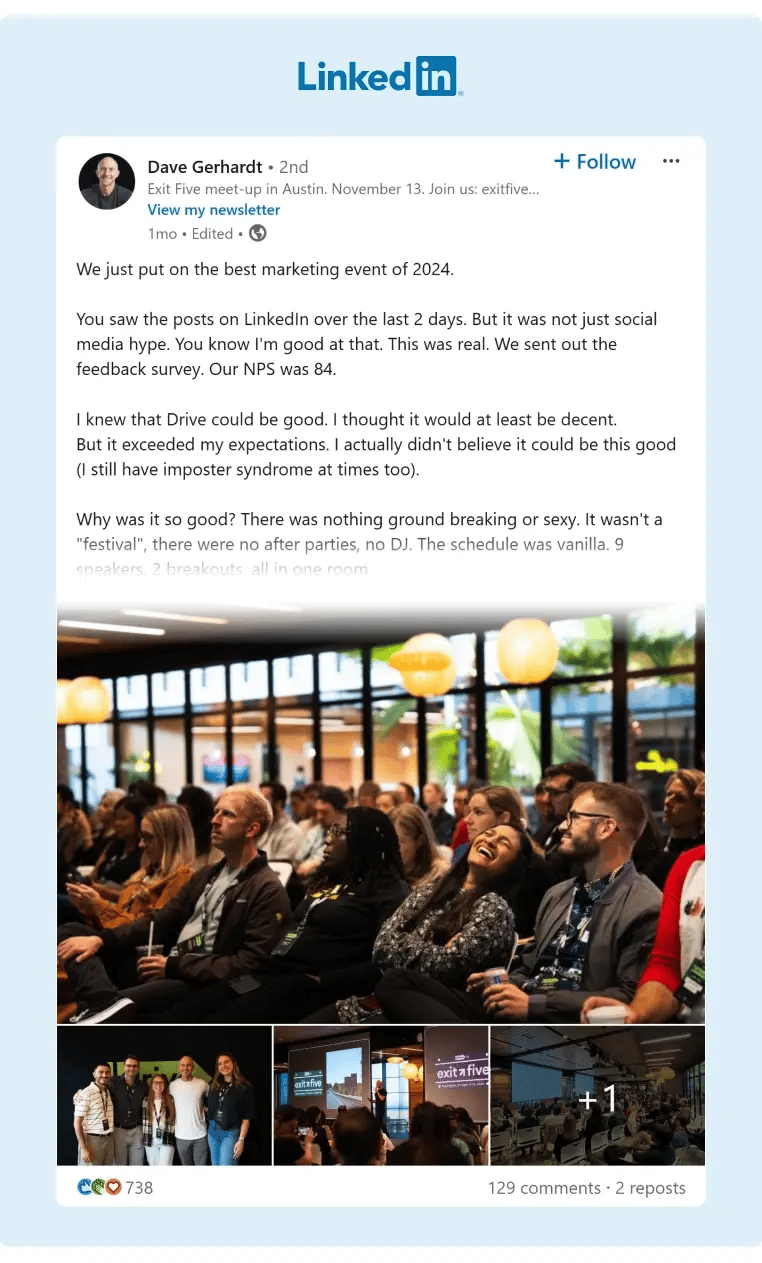
Source: Dave Gerhardt
With 737+ reactions, this post celebrates the success of Exit Five’s first in-person event. Using an organized numbered format, Dave’s posts share:
- Data.
- Stories.
- Images.
- Feedback.
- Step-by-step instructions.
Now, Dave and his team are using brand and employee advocacy on LinkedIn to expand Exit Five’s reach through the company page’s posts. Without Dave’s posts, Exit Five wouldn’t have as much traction (as seen with the nine reactions). In this case, it’s savvy to use his platform while he’s building Exit Five’s platform.

Source: Exit Five
Through his and Exit Five’s posts, Gerhardt gives a glimpse into the inner workings of his new company and illustrates the power of a strong community.
Takeaway: Use your (or your thought leaders’) popularity to help your business grow faster, especially when it's just starting. Then, share stories, data, and feedback from your audience to share the story of your growth in a way that gives your audience FOMO.
Case Study 3: Katelyn Bourgoin Teaches Behavioral Psychology to Marketers
The Buyer Psychologist Katelyn Bourgoin ("The Customer Whisperer”) is a popular marketing thought leader and founder. Her posts are a can’t miss for marketers who value her customer research and buyer psychology expertise. What sets her posts apart from other marketing experts? Let’s take a look.
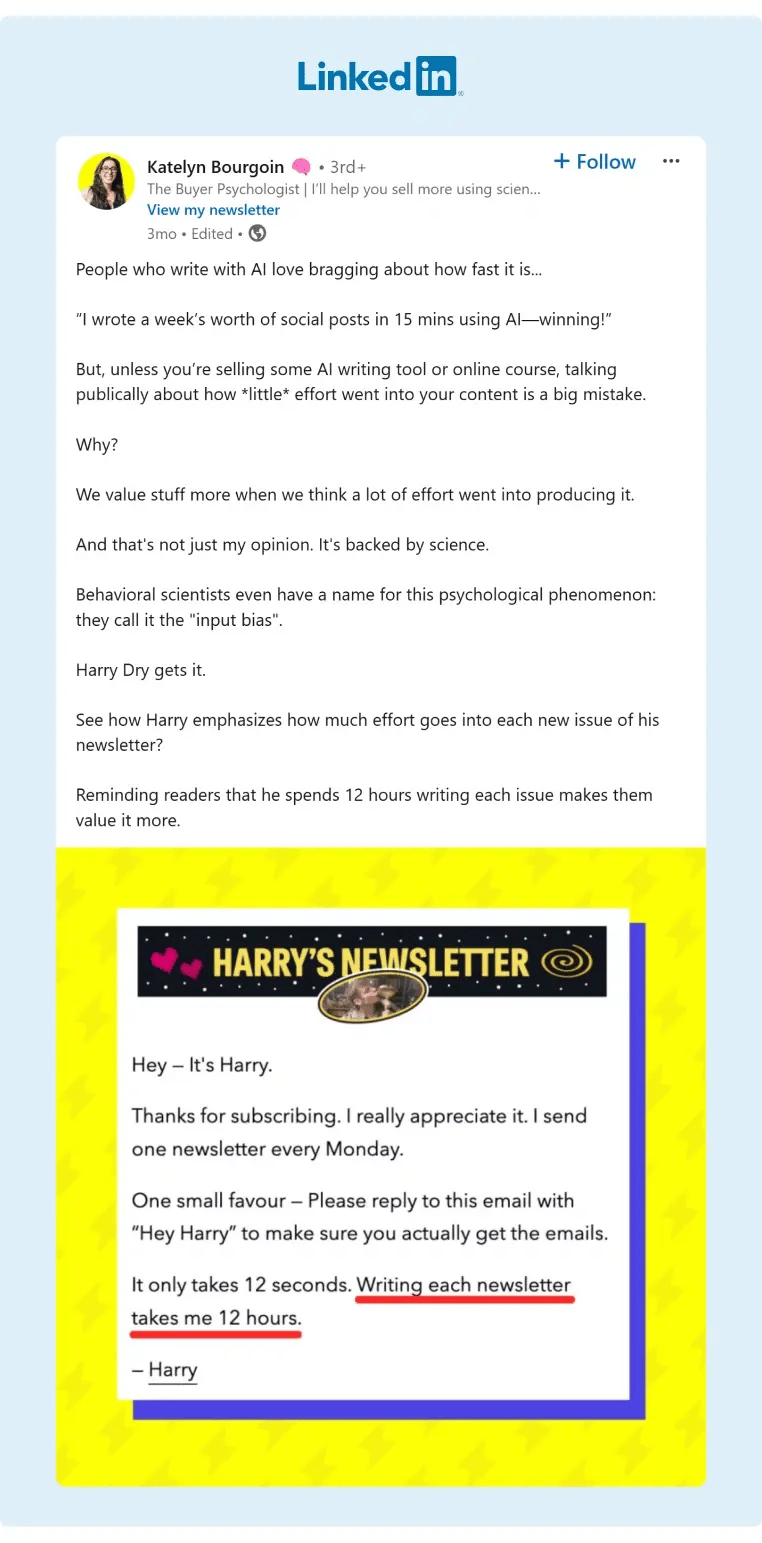
Source: Katelyn Bourgoin
At first sight, her yellow and blue branding is consistent with her newsletter and company page. An expert at building personal brand awareness, you know it’s a Katelyn Bourgoin post when you see it — and it’s fun at first sight. Next, she uses examples and explains the part behavioral psychology plays in how marketing works (or doesn’t). Her posts are concise and chock-full of details, making them fun to read.

Source: Katelyn Bourgoin
Katelyn explains how buyer psychology works in a relatable and easy-to-understand way, and she helps marketers understand their customers and fine-tune their products and marketing strategies. She found a niche in buyer behavioral psychology and, over the years, has built a hoard of raving fans because her posts pack in value.
Takeaway: A unique, recognizable style can make your content stand out. Also, providing value to your audience in a relatable, easy-to-understand way can help you build a dedicated following.
True thought leadership is a long game. By consistently focusing on your area of expertise and sharing actionable insights, you can build a loyal following and establish yourself as a go-to resource in your field.
Start Building Thought Leadership Today
Ready to use thought leadership to build an audience? Get started by making it easy for your employees to become brand advocates by connecting, sharing insights, and engaging on social media. By showing them the perks — personal brand building increased value to the company — you’ll likely convince employees and executives to volunteer to post thought leadership content on their social media profiles.
Identify your employee segments: the social media savvy, the keen learners, and the not-interested. Your goal? Motivate the first two by making it easy and worthwhile.
That’s where GaggleAMP comes in. Our employee advocacy platform makes suggesting social media actions a breeze, boosting your brand and your employees' social media presence and engagement.
With GaggleAMP, you can amplify your thought leadership, drive your business forward, and enhance lead generation, social selling, and more. Ready to level up your employee advocacy efforts? Schedule a GaggleAMP demo today.








